+ Open data
Open data
- Basic information
Basic information
| Entry | Database: PDB / ID: 6z6p | ||||||
|---|---|---|---|---|---|---|---|
| Title | HDAC-PC-Nuc | ||||||
 Components Components |
| ||||||
 Keywords Keywords | GENE REGULATION / Protein complex | ||||||
| Function / homology |  Function and homology information Function and homology informationHDA1 complex / : / HSF1 activation / HDACs deacetylate histones / nucleosome array spacer activity / histone deacetylase activity, hydrolytic mechanism / histone deacetylase / regulatory ncRNA-mediated gene silencing / SUMOylation of chromatin organization proteins / histone deacetylase complex ...HDA1 complex / : / HSF1 activation / HDACs deacetylate histones / nucleosome array spacer activity / histone deacetylase activity, hydrolytic mechanism / histone deacetylase / regulatory ncRNA-mediated gene silencing / SUMOylation of chromatin organization proteins / histone deacetylase complex / epigenetic regulation of gene expression / chromosome segregation / structural constituent of chromatin / nucleosome / heterochromatin formation / nucleosome assembly / chromatin organization / protein heterodimerization activity / chromatin binding / regulation of transcription by RNA polymerase II / negative regulation of transcription by RNA polymerase II / positive regulation of transcription by RNA polymerase II / DNA binding / nucleoplasm / identical protein binding / nucleus / cytosol Similarity search - Function | ||||||
| Biological species |  unidentified plasmid (others) | ||||||
| Method | ELECTRON MICROSCOPY / single particle reconstruction / cryo EM / Resolution: 4.43 Å | ||||||
 Authors Authors | Lee, J.-H. / Bollschweiler, D. / Schaefer, T. / Huber, R. | ||||||
| Funding support |  Germany, 1items Germany, 1items
| ||||||
 Citation Citation |  Journal: Sci Adv / Year: 2021 Journal: Sci Adv / Year: 2021Title: Structural basis for the regulation of nucleosome recognition and HDAC activity by histone deacetylase assemblies. Authors: Jung-Hoon Lee / Daniel Bollschweiler / Tillman Schäfer / Robert Huber /  Abstract: The chromatin-modifying histone deacetylases (HDACs) remove acetyl groups from acetyl-lysine residues in histone amino-terminal tails, thereby mediating transcriptional repression. Structural makeup ...The chromatin-modifying histone deacetylases (HDACs) remove acetyl groups from acetyl-lysine residues in histone amino-terminal tails, thereby mediating transcriptional repression. Structural makeup and mechanisms by which multisubunit HDAC complexes recognize nucleosomes remain elusive. Our cryo-electron microscopy structures of the yeast class II HDAC ensembles show that the HDAC protomer comprises a triangle-shaped assembly of stoichiometry Hda1-Hda2-Hda3, in which the active sites of the Hda1 dimer are freely accessible. We also observe a tetramer of protomers, where the nucleosome binding modules are inaccessible. Structural analysis of the nucleosome-bound complexes indicates how positioning of Hda1 adjacent to histone H2B affords HDAC catalysis. Moreover, it reveals how an intricate network of multiple contacts between a dimer of protomers and the nucleosome creates a platform for expansion of the HDAC activities. Our study provides comprehensive insight into the structural plasticity of the HDAC complex and its functional mechanism of chromatin modification. | ||||||
| History |
|
- Structure visualization
Structure visualization
| Movie |
 Movie viewer Movie viewer |
|---|---|
| Structure viewer | Molecule:  Molmil Molmil Jmol/JSmol Jmol/JSmol |
- Downloads & links
Downloads & links
- Download
Download
| PDBx/mmCIF format |  6z6p.cif.gz 6z6p.cif.gz | 729.2 KB | Display |  PDBx/mmCIF format PDBx/mmCIF format |
|---|---|---|---|---|
| PDB format |  pdb6z6p.ent.gz pdb6z6p.ent.gz | 560.5 KB | Display |  PDB format PDB format |
| PDBx/mmJSON format |  6z6p.json.gz 6z6p.json.gz | Tree view |  PDBx/mmJSON format PDBx/mmJSON format | |
| Others |  Other downloads Other downloads |
-Validation report
| Summary document |  6z6p_validation.pdf.gz 6z6p_validation.pdf.gz | 923.9 KB | Display |  wwPDB validaton report wwPDB validaton report |
|---|---|---|---|---|
| Full document |  6z6p_full_validation.pdf.gz 6z6p_full_validation.pdf.gz | 988.2 KB | Display | |
| Data in XML |  6z6p_validation.xml.gz 6z6p_validation.xml.gz | 89.9 KB | Display | |
| Data in CIF |  6z6p_validation.cif.gz 6z6p_validation.cif.gz | 142.4 KB | Display | |
| Arichive directory |  https://data.pdbj.org/pub/pdb/validation_reports/z6/6z6p https://data.pdbj.org/pub/pdb/validation_reports/z6/6z6p ftp://data.pdbj.org/pub/pdb/validation_reports/z6/6z6p ftp://data.pdbj.org/pub/pdb/validation_reports/z6/6z6p | HTTPS FTP |
-Related structure data
| Related structure data |  11102MC  6z6fC  6z6hC  6z6oC M: map data used to model this data C: citing same article ( |
|---|---|
| Similar structure data |
- Links
Links
- Assembly
Assembly
| Deposited unit | 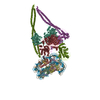
|
|---|---|
| 1 |
|
- Components
Components
-Histone deacetylase ... , 2 types, 2 molecules KL
| #1: Protein | Mass: 74851.953 Da / Num. of mol.: 1 Source method: isolated from a genetically manipulated source Source: (gene. exp.)  Gene: HDA1, YNL021W, N2819 / Production host:  |
|---|---|
| #2: Protein | Mass: 76017.211 Da / Num. of mol.: 1 Source method: isolated from a genetically manipulated source Source: (gene. exp.)  Gene: HDA1, YNL021W, N2819 / Production host:  |
-HDA1 complex subunit ... , 2 types, 2 molecules MN
| #3: Protein | Mass: 63422.098 Da / Num. of mol.: 1 Source method: isolated from a genetically manipulated source Source: (gene. exp.)  Gene: HDA3, PLO1, YPR179C / Production host:  |
|---|---|
| #4: Protein | Mass: 71915.297 Da / Num. of mol.: 1 Source method: isolated from a genetically manipulated source Source: (gene. exp.)  Gene: HDA2, PLO2, YDR295C / Production host:  |
-Protein , 8 types, 8 molecules ABCDEFGH
| #5: Protein | Mass: 11431.358 Da / Num. of mol.: 1 Source method: isolated from a genetically manipulated source Source: (gene. exp.)  |
|---|---|
| #6: Protein | Mass: 9409.056 Da / Num. of mol.: 1 Source method: isolated from a genetically manipulated source Source: (gene. exp.)  |
| #7: Protein | Mass: 11294.136 Da / Num. of mol.: 1 Source method: isolated from a genetically manipulated source Source: (gene. exp.)  |
| #8: Protein | Mass: 10607.212 Da / Num. of mol.: 1 Source method: isolated from a genetically manipulated source Source: (gene. exp.)  |
| #9: Protein | Mass: 11405.321 Da / Num. of mol.: 1 Source method: isolated from a genetically manipulated source Source: (gene. exp.)  |
| #10: Protein | Mass: 8795.306 Da / Num. of mol.: 1 Source method: isolated from a genetically manipulated source Source: (gene. exp.)  |
| #11: Protein | Mass: 11494.393 Da / Num. of mol.: 1 Source method: isolated from a genetically manipulated source Source: (gene. exp.)  |
| #12: Protein | Mass: 10348.852 Da / Num. of mol.: 1 Source method: isolated from a genetically manipulated source Source: (gene. exp.)  |
-DNA chain , 2 types, 2 molecules IJ
| #13: DNA chain | Mass: 44520.383 Da / Num. of mol.: 1 / Source method: obtained synthetically / Source: (synth.) unidentified plasmid (others) |
|---|---|
| #14: DNA chain | Mass: 44991.660 Da / Num. of mol.: 1 / Source method: obtained synthetically / Source: (synth.) unidentified plasmid (others) |
-Non-polymers , 1 types, 2 molecules 
| #15: Chemical |
|---|
-Details
| Has ligand of interest | Y |
|---|---|
| Has protein modification | Y |
-Experimental details
-Experiment
| Experiment | Method: ELECTRON MICROSCOPY |
|---|---|
| EM experiment | Aggregation state: PARTICLE / 3D reconstruction method: single particle reconstruction |
- Sample preparation
Sample preparation
| Component |
| ||||||||||||||||||||||||||||||
|---|---|---|---|---|---|---|---|---|---|---|---|---|---|---|---|---|---|---|---|---|---|---|---|---|---|---|---|---|---|---|---|
| Source (natural) |
| ||||||||||||||||||||||||||||||
| Source (recombinant) |
| ||||||||||||||||||||||||||||||
| Buffer solution | pH: 7.5 | ||||||||||||||||||||||||||||||
| Specimen | Embedding applied: NO / Shadowing applied: NO / Staining applied: NO / Vitrification applied: YES | ||||||||||||||||||||||||||||||
| Vitrification | Cryogen name: ETHANE |
- Electron microscopy imaging
Electron microscopy imaging
| Experimental equipment |  Model: Titan Krios / Image courtesy: FEI Company |
|---|---|
| Microscopy | Model: FEI TITAN KRIOS |
| Electron gun | Electron source:  FIELD EMISSION GUN / Accelerating voltage: 300 kV / Illumination mode: OTHER FIELD EMISSION GUN / Accelerating voltage: 300 kV / Illumination mode: OTHER |
| Electron lens | Mode: OTHER |
| Image recording | Electron dose: 77.2 e/Å2 / Film or detector model: GATAN K3 BIOQUANTUM (6k x 4k) |
- Processing
Processing
| Software |
| ||||||||||||||||||||||||
|---|---|---|---|---|---|---|---|---|---|---|---|---|---|---|---|---|---|---|---|---|---|---|---|---|---|
| EM software |
| ||||||||||||||||||||||||
| CTF correction | Type: NONE | ||||||||||||||||||||||||
| Symmetry | Point symmetry: C1 (asymmetric) | ||||||||||||||||||||||||
| 3D reconstruction | Resolution: 4.43 Å / Resolution method: FSC 0.143 CUT-OFF / Num. of particles: 41279 / Symmetry type: POINT | ||||||||||||||||||||||||
| Atomic model building | Details: Real space refinement | ||||||||||||||||||||||||
| Refinement | Cross valid method: NONE Stereochemistry target values: GeoStd + Monomer Library + CDL v1.2 | ||||||||||||||||||||||||
| Displacement parameters | Biso mean: 407.11 Å2 | ||||||||||||||||||||||||
| Refine LS restraints |
|
 Movie
Movie Controller
Controller








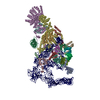
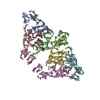

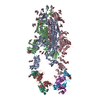


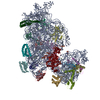
 PDBj
PDBj








































